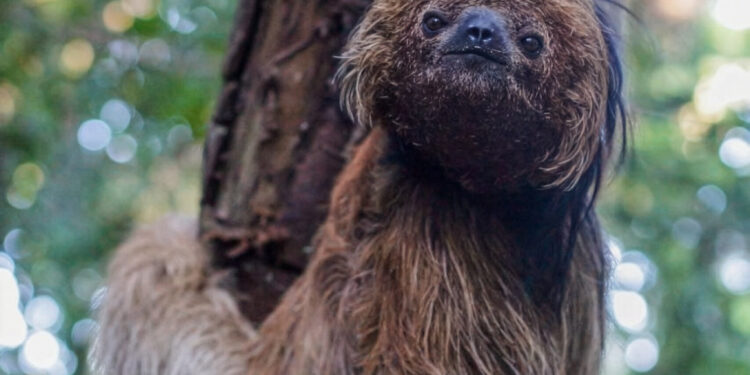Northern maned sloth (Bradypus torquatus). Credit: Instituto Tamandua
The northern and southern maned sloths may look very similar from the outside, but their genomes reveal different stories: The two species faced very distinct conditions in Brazil’s Atlantic Forest in the past and face different conservation threats today.
In an article recently published in the journal Molecular ecologyscientists from the Leibniz Institute for Zoo and Wildlife Research (Leibniz-IZW), in partnership with the Brazilian NGO Instituto Tamanduá, show that the southern lineage, currently more endangered, has lower genetic diversity than the northern lineage, which shows a rapid increase in inbreeding in recent decades. The results demonstrate that genomic studies can offer essential information for the conservation of endangered species.
From November 10 to 21, conservation leaders from around the world will gather in Brazil for the 30th Conference of the Parties (COP30) of the United Nations Framework Convention on Climate Change (UNFCCC). The country is home to several globally significant biodiversity hotspots, regions that not only boast species diversity but also contribute to a stable global climate, provided they are adequately protected. The new study by Leibniz-IZW and the Instituto Tamanduá offers important information for the conservation of biodiversity in Brazil’s tropical forests.
The Atlantic Forest, the highly diverse coastal rainforest of South America, once covered a significant portion of Brazil’s territory. Due to human activities such as land clearing for agriculture and urbanization, only about 8% of its original extent remains today. Although severely reduced and fragmented, the Atlantic Forest still serves as habitat for a multitude of fascinating and resilient species. Among these species are the maned sloths, which are found nowhere else on the planet.
Working closely with the Brazilian conservation NGO Instituto Tamanduá, Leibniz-IZW scientists were able to sequence entire genomes of two closely related sloth species from Brazil’s Atlantic Forest: the northern maned sloth (Bradypus torquatus) and the southern maned sloth (Bradypus crinitus).
A species’ genome is equivalent to its genetic “blueprint,” and the process of genome sequencing involves converting the information in DNA into data that scientists can analyze.
By studying the sloth genome, the goal was to investigate how ancient climate changes and recent human-induced habitat shifts have shaped the species’ genetic diversity, population history, and current conservation status.
Southern maned sloth (Bradypus crinitus). Credit: Instituto Tamandua
Genomic information for conservation
Some of the key results of the studies show that the southern maned sloth, which is currently more endangered, has lower genetic diversity and also a lower historical population size than its northern relatives. This finding likely reflects the distinct environmental and climatic conditions that the two regions have experienced in the past.
But the situation is also worrying for the northern maned sloth: despite its higher genetic diversity and larger current population, inbreeding – characterized by the mating of related individuals – has seen a rapid increase in recent decades. This is likely due to recent deforestation and habitat fragmentation in the northern region.
The study also shows that the Nordic lineage carries a higher genetic load (i.e. more disadvantageous genetic variants), which could be dangerous if the trend of population decline is not reversed. “By revealing key aspects of the genetic health of the species, these results allow us to design conservation actions truly focused on what the species needs most,” said Larissa Arantes, a scientist at Leibniz-IZW who led the work.
These key discoveries buried deep in the sloth genome show that each lineage has unique conservation needs, shaped by both profound environmental changes and modern threats to their tropical habitat.
Why it matters
This study provides genomic insight into a species living in one of the world’s most threatened biodiversity hotspots. Despite the importance of these very diverse regions, this type of data is only available for a very limited number of species present there. The work offers actionable genetic information to manage vulnerable populations. In particular, the results highlight the urgency of preserving genetic diversity, mitigating inbreeding, and maintaining habitat connectivity for the long-term survival of these sloths.
“Genomic erosion poses a serious threat to populations under pressure, especially with increasing inbreeding. This should serve as a warning that fragmentation reduces the chances of survival of the maned sloth, especially in the northern region of Bahia. We will continue our close partnership with the Instituto Tamanduá to assess the extent of the impact on the genomic health of the maned sloth,” says Camila Mazzoni, head of the Evolutionary and Conservation Genomics Research Group. conservation at Leibniz-IZW and main author. of the study.
Far beyond collecting the samples that made this genomic study possible, the NGO Instituto Tamanduá has years of experience in carrying out a wide range of concrete actions to protect these and other species of sloths and anteaters. From describing a new species of maned sloth to restoring its natural habitat through reforestation, everything the organization does is guided by science and generates new scientific knowledge, including studies like this one.
More information:
Larissa S. Arantes et al, Genomic signatures in three-toed maned sloths from ancient to recent environmental changes in Brazil’s threatened Atlantic Forest, Molecular ecology (2025). DOI: 10.1111/mec.70148
Provided by the Leibniz Institute for Zoo and Wildlife Research
Quote: Maned sloth genomes show distinct impacts of habitat loss and inbreeding (November 7, 2025) retrieved November 7, 2025 from
This document is subject to copyright. Except for fair use for private study or research purposes, no part may be reproduced without written permission. The content is provided for informational purposes only.



